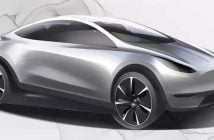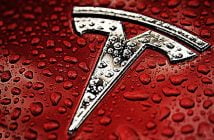+++ The facelifted version of the third-generation BMW 1 Series is in development and a hot M135i will be part of the update. In its mid-life update, BMW’s premium hatch will receive a suite of interior and exterior tweaks. The M135i hot hatch will get new quad exhausts, a wider grille more inline with the new 2 Series and new bumpers front and back. The larger air intakes at the front could mean the M135i requires additional cooling for its turbocharging system – potentially as a result of more power being squeezed out of it’s 306 hp, 2.0-litre turbocharged 4-cylinder engine. The drivetrain will remain the same, with power sent to all four wheels. The standard 1 Series facelift brings a new front grille, as well the combination of new bumpers all around and a tweaked headlight and rear light signature. Inside, the new 1 Series we can already see alterations from the current car’s technology. We’re almost certainly going to get the same 12.3-inch digital driver’s display and 10.25-inch touchscreen taken from the new 2 Series. The iDrive rotary controller will be removed in favour of a touch-only screen as BMW plans to reserve the feature for its larger models. The gear lever has also been shrunk from the usual stick shape to a small nub. The current 1 Series sits on the same UKL2 platform as the second-generation X1 (recently replaced by a new third-generation X1). We won’t see a fully-electric 1 Series just yet, because BMW is positioning the upcoming iX1 as the firm’s smallest EV. It’s certainly possible that the 1 Series facelift will feature some form of hybrid technology for the first time, however. The 1 Series range could expand to include a plug-in hybrid engine option based on the 10 kWh battery supported setup in the outgoing X1. This would likely deliver more than the old X1’s 50 km of electric-only range thanks to the smaller proportions and better aerodynamic efficiency of the 1 Series. These hybrid options would complement a number of 3 and 4-cylinder petrol and diesel engines in the new 1 Series engine range when the car goes on sale sometime in 2023. +++
+++ HONDA revealed the new Civic Type R just over a month ago with some preliminary details. Today, Honda is getting much deeper into what’s new and providing a ton of specs to pore over. The revised 2.0-liter turbocharged 4-cylinder engine is rated at 330 hp and 415 Nm, representing increases of 10 hp and 15 Nm respectively. Honda says the extra power and torque comes courtesy of a redesigned turbocharger, intake and exhaust system. The turbo features newly shaped and sized turbine blades, and Honda says that this combined with a better flowing intake enables the turbo to generate pressure over a wider range. As for the exhaust, it features an active exhaust valve that opens up at higher rpm, emitting a louder sound. In an effort to cool the more powerful engine, Honda says the new Type R features a larger grille opening than before, a bigger radiator and a larger-diameter fan. Enhanced cooling for track use was one of the big targets for the previous-gen Type R’s refresh, so we like to see that Honda has made it a priority right out of the gate with this new Type R. The only transmission available is a 6-speed manual. The gearbox is improved from the previous 6-speed with a new high-rigidity lever and an “optimized shift gate pattern” for a “hyper-precise gear change”. It also gets a lighter flywheel and a rev-match system. Chassis specs and suspension changes are in this info drop, and just like the non-R Civic, it’s sporting a wheelbase which is 3,5 cm longer than the previous generation. The front track is 2,5 cm wider and the rear track is 2 cm wider than the old R, too. Honda’s magical dual-axis strut front suspension design that makes torque steer disappear is back, but it’s been re-tuned for this generation. The multilink rear suspension is re-tuned, too, and Honda claims these changes in front and rear improve straight-line stability and steering feel. It’s all riding on new 19-inch matte black wheels that make use of what Honda calls a “reverse rim” design meant to improve the stability of the tire contact patch when under load. These wheels are wrapped in Michelin Pilot Sport 4S tires measuring 265-section-width at all 4 corners; that’s 20 mm more than before. Hidden behind the wheels are two-piece front brake rotors, and the braking system as a whole is optimized with a re-tuned brake booster. Brake cooling is also improved, and Honda says it’s made improvements in both feel and controllability. Honda says this new Type R is both more aerodynamically efficient and provides more downforce than the previous generation. All of the aero (like the new rear wing and rear diffuser) was designed with input from development members of the HRD Sakura Super GT racing team. As for the interior, Honda says occupants sit lower than before, but also claims enhanced visibility thanks to thinner A-pillars, relocated side mirrors and a lower hood. The red sport seats are lighter and feature “suede-effect” upholstery for extra grip on track. Those red seats are the only colour option inside, and the same goes for that scorching red carpet. Interior tech is getting a massive boost in line with the regular Civic, so you’ll find a 9-inch touchscreen with wireless Apple CarPlay and wireless Android Auto, a wireless phone charger, a Bose Centerpoint premium audio system, digital gauge cluster with multiple view modes, new drive mode control with a customizable “Individual” mode and an updated version of Honda’s LogR Performance Datalogger. Beyond all the above details, Honda had nothing else new to share that we haven’t already covered in the car’s initial reveal. That means there is still no price. Yes, we’re disappointed, too. Honda says this Type R’s engine will be built at Honda’s Anna Engine Plant in Ohio, but the vehicle will be assembled at the Yorii Plant in Japan. It will launch in the fall, and Honda says to expect pricing and even more details to be available as we near the full launch. +++
+++ Global passenger PLUG-IN ELECTRIC CARS sales do not disappoint and, considering that the overall car market is down, look very promising. Some 778.092 new passenger plug-in electric cars (full-electric and PHEV) were registered in July, which is 61% more than a year ago. That’s one of the best monthly results and the best first month of a quarter. Compared to the overall market, plug-ins hold 14% of the market (including 10% for full electric cars thanks to sales of 556.000 units). It’s amazing that 1 in 10 new cars is already 100% electric and the segment is expanding at a healthy pace against all challenges. Meanwhile, conventional hybrids are down year-over-year for the 4th consecutive month. Is this what prompted Toyota to invest more in BEV (Battery Electric Vehicle) production? In the first 7 months of 2021, more than 4.9 million (4.928.376 to be exact) new passenger plug-in electric cars were registered globally, compared to almost 6.5 million in the 12 twelve months of 2021. Full electric cars sold 3.66 million times and had a 8.9% marketshare. PHEVs did 1.27 million (3.1% share). Together, they had 12% marketshare. July was an especially good month for BYD, which put multiple models in the top 10, including the Song BEV/PHEV (37.784) at #1 and the Qin Plus BEV/PHEV (30.115) at #3. Between these 2 cars, we can see the Wuling Hong Guang Mini EV micro car (37.129). The Tesla Model Y was fourth with 29.829 sales, but at the same time, it was also the best monthly result for the first month of a quarter. Next came the BYD Han (BEV + PHEV; 25.293, the BYD Dolphin (20.546) and the BYD Yuan Plus (BEV; 19.295). Interesting is also the 19.035 sales set by the Volkswagen ID.4; a record number for the German brand. It also meant it beat the Tesla Model 3 at 17.246 sales. The GAC Aion Y made the top-10 complete with 12.530 sales. The Tesla Model Y remains the top selling plug-in car model after the first 7 months of the year, with a huge advantage over the Wuling Hong Guang Mini EV micro car (344.928 versus 244.961). The Tesla Model 3 is third with 236.518 sales, but its advantage over the top BYD models (Song: 196.875, Qin Plus: 162.610 and Han: 122,518) is shrinking (although only when counting BEVs and PHEVs together, as in the data source). Next came: Volkswagen ID.4 – 82.632, BYD Dolphin – 79.151, BYD Yuan Plus – 74.258, Li Xiang One EREV – 70.826, BYD Tang – 68.816, Chery QQ Ice Cream – 63.478, Hyundai Ioniq 5 – 60.985, Changan Benni EV – 60.273, Chery eQ1 – 58.116, GAC Aion Y – 56.781, Hozon Neta V – 49.401, Kia EV6 – 48.131, GAC Aion S – 46.788 and Ford Mustang Mach-E – 45.474. In July, BYD noted a huge record of 160.061 plug-in electric car registrations, which is over 3 times more than Tesla at 52.084. The third top brand was Volkswagen with a record of 46.400 units. Next came SAIC-GM-Wuling (40.275), GAC (25.094), Geely (24.599), Chery (24.498), BMW (24.175), Dongfeng (19.680) and Hyundai (18.348). So far this year, the top brand is BYD, followed by Tesla, while the SAIC-GM-Wuling is the best of the rest. +++
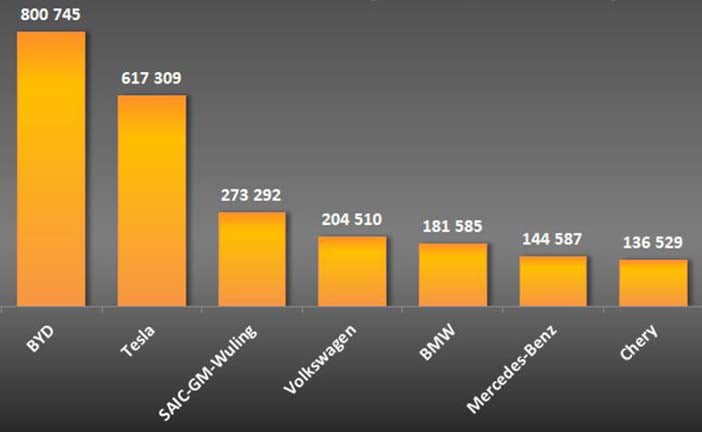
+++ In the spring of this year, POLESTAR gave the 2 a massive software update which brought many improvements for the electric vehicle. The exterior, however, was left unchanged but it seems that the Swedish manufacturer is preparing a facelift for the zero-emissions liftback after all. I suppose Polestar will give the model a new grille design. There could be other changes to the front bumper and the panel about the grille. Nothing will change on the side, aside from a new wheel design. It will be interesting to see whether this visual upgrade for the Polestar 2 will also bring hardware improvements or new software updates for improved efficiency. +++
+++ SONO MOTORS is an EV startup whose ambition was to develop and sell an affordable solar electric hatchback that would essentially democratise solar EVs in a way other manufacturers have so far not been able to. Last October, I reported that the company had reached 15,000 paid reservations for its Sion model, and since then it has shown what is basically the finished production version of the solar EV and most recently it announced that reservations have passed the 20.000 mark. All these 20.000 private reservations are paid, with the average down payment being around the €2.000 mark, according to Sono Motors, although some have already paid considerably more of the €25.126 net asking price. Production is still about one year away, though, but it should start in the second half of 2023 if all goes to plan. The Sono Sion will be manufactured by Valmet Automotive in Finland it could start reaching customers late next year or in early 2024. What makes the Sion special are the solar cells embedded into pretty much any flat surface on its body: the bonnet, the roof, the wings/fenders, the quarter panels and the hatch in the back. Only the front fascia is completely devoid of solar panels, but that’s because the frontal section needs to be easy and relatively cheap to replace in the event of an accident. Sono says that the Sion’s impressive array of 456 solar cells should give it an average of 112 km of free range every week and that number can be more than double in sunny conditions. Being based in Germany, though, the company is keeping its extra range estimate conservatory, but based on our own past talks with company representatives, they know it can provide more. With no free energy from the Sun, the Sion’s 54 kWh battery pack will take it 305 km on the WLTP test cycle. Charging isn’t especially quick, capped at 75 kW, but given the relatively small battery, it needs just 35 minutes to be charged up to 80 percent and an extra 24 minutes on top of that for the battery to be brimmed. +++
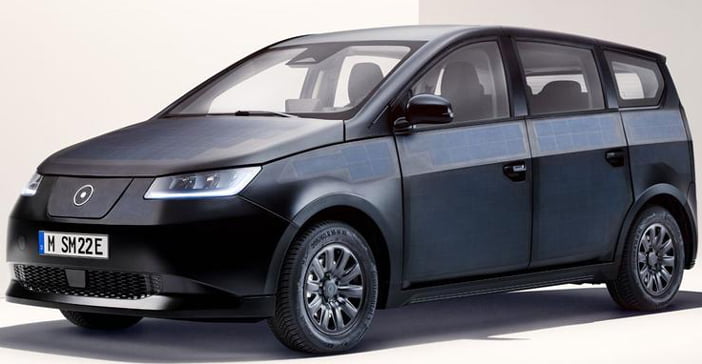
+++ SUBARU has dropped a teaser video for what they’re coyly calling a “new SUV”. Based on what we can see from the shadowy silhouette, it sure looks like a redesigned XV. The only official statement from Subaru is that a global premiere will take place on September 15. That timing would fall in line for a new XV. The second generation debuted 5 years ago, in 2017. However, whether it’s all-new is up for debate. Subaru hasn’t updated the Impreza that the XV is based on since 2016, so it could be a heavily facelifted model like in the spy shots we saw in December 2021. I wouldn’t let the “new SUV” tagline throw you. The teaser was made by Subaru in Japan, where anything made with an outdoorsy lifestyle qualifies as a SUV, even vehicles we might call crossovers. The teaser does such a great job at hiding the car without the use of purposefully dim studio lighting that we almost have to applaud the effort. The car moves through natural environments, but its sheetmetal is obscured by a thick forest, rooftop tent, dust kicked up on a dirt trail, and a dark cave. They cleverly match the outdoorsy vibe that XV owners imagine when they choose an AWD Subaru, but don’t give too much away. The closeups that we are privy to include the large C-shaped taillights that we saw in the December spy shots, revamped headlights, and revised grille. Subaru has done an admirable job of making the XV distinctive enough from similar vehicles in its class while keeping the design consistent and unmistakable XV through generations. It appears this next one will remain faithful to that formula. We’ll know for sure in a couple of weeks. +++
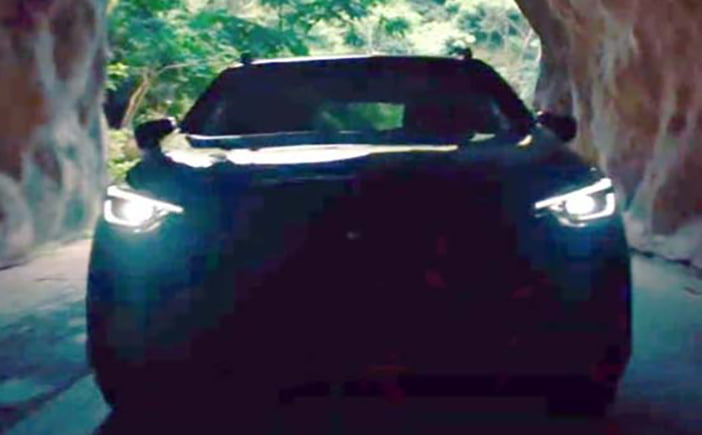
+++ It seems we’re constantly talking about the demand for TESLA ’s vehicles and the demand for EVs in general. For years, there was reportedly “no demand” for Tesla’s EVs, people didn’t want EVs, the demand had fallen off a cliff, and bankruptcy was looming. However, in reality, the demand is growing like crazy, and that has been the case for many years now. But Tesla is currently in the midst of unprecedented demand. This comes as no surprise, as we’ve been watching and reporting for many months about the fact that Tesla can’t possibly produce enough cars to fill orders in a timely fashion. In fact, the EV maker is so backed up that it has had to delay upcoming models over and over again. Fortunately, Tesla has opened a new factory in Germany and another in Texas. Meanwhile, the company is upgrading its Gigafactory in Shanghai, China, and it has future plans to expand in Fremont, California. The reason we’re publishing another article about Tesla’s demand even though it’s not necessarily new news is that Wall Street analyst Pierre Ferragu of New Street Research just attended an event for analysts that was held by Tesla at its Gigafactory in Berlin. Ferragu had the opportunity to see the factory and speak with the EV maker’s management team. While automakers across the globe struggle to get parts and produce cars, Tesla has been able to continue to show consistent successes with regard to production, deliveries, and profits. Tesla is raising the prices on all of its models often, and people are still placing orders much more quickly than the automaker can fill them. Throw in the fact that fuel prices have soared and it’s also difficult to get most rivals’ models, and Tesla is in a uniquely positive position. That said, there comes a point when people will get tired of waiting for their cars. Tesla has actually gone so far as to stop taking orders for some models until it can better satisfy demand. Fortunately, we’ve seen several positive reports lately of delivery times for Tesla’s vehicles finally beginning to become more manageable. Ferragu shared in a note to his clients: “Tesla is facing unprecedented demand. Everybody I know at Tesla and with whom I could discuss that topic agrees that demand is way above what hopes were a few years ago. Electric cars are so popular that for Tesla and their competitors, market shares will mostly be dictated by their ability to ramp volumes”. The analyst seemed most impressed with how efficient Tesla’s operations are at Giga Berlin. He shared that it’s much more efficient than Fremont, logistics are simplified, and the factory design makes processes more streamlined. Ferragu believes that over the long term, Tesla could potentially be a $10 trillion company by 2030. However, that would only be the case if Tesla was able to meet its goal of producing 20 million EVs annually by that time. +++
+++ I recently spent the day with a TESLA MODEL S Plaid to give you all a comprehensive review of what it’s like being behind the wheel of this tri-motor electric muscle liftback. Many things about it were impressive: the acceleration, stellar tech and great range. There were a handful of negatives, too, but here I’m going to focus on how the Plaid’s interior has held up over its 35.000 km. The most obvious problem was staring us in the face right after opening the door. Tesla’s yoke steering device looked like it had been attacked by a wild animal. Its covering was worn and stripped away on both sides of the yoke’s vertical bars, leaving the somewhat uncomfortable bare yoke below it. Yeah, this looks bad, bad. Now, some caveats. This Model S Plaid is a rental that’s been on Turo for an undetermined amount of time. According to the listing, it’s only been out on 7 total trips, including ours. The rental life is hard on any car. Even so, being used and likely abused as a rental, this kind of wear and tear is something we’ve never seen before on rentals with a similar number of miles. Maybe one with 100,000, but less than 20,000? Clorox wipes and hand sanitizer is going to be rough on any car interior, but still, this kind of damage is egregious. For a moment, too, I thought there was a chance this yoke was an outlier. Or maybe somebody defaced it on purpose in a previous rental trip? But recent online revelations by other Plaid owners defeat this theory. In tweets, Model S owners detailed the degradation of their own yokes, showing that our experience is not abnormal. We’re fast approaching the point where many Model S Plaid owners will be hitting similar mileage marks as my rental. Unless Tesla quietly improved the quality of its yoke covering over the past year, I suspect that this will be a common occurrence. In addition to it just looking bad, this fast-wearing cover speaks to the sort of durability testing Tesla does. Of all the things you touch in a car, more wear and tear is put on the steering wheel and seats than anywhere else. You’d think that Tesla would want to make sure its brand-new, fancy steering device was a bulletproof part, right? Since Tesla lacks a PR or communications department, I can’t actually ask Tesla what its testing and quality assurance scheme was for the yoke, but we can surmise from the results that whatever was done wasn’t enough. Besides the yoke, my rented Model S Plaid’s seats were rather gross to look at with differences in appearance between the unsullied tops of the seats versus the flat-out gross bottoms. White seats are always a gamble when it comes to car interiors, but again, I’ve never seen any that are this discoloured after just a year of use. I’ve had long-term test cars with white or cream interiors for a year-plus, and they’ve never ended up looking like this. Once again, this speaks to the durability of materials used. Outside of the yoke and seat issues, the only other big problem was black trim being chipped off one of the emergency door release latches. This could very easily be the fault of a ring or some other hard material being pushed into it with some force, which is less of a Tesla issue and more user error. The rest of the interior in this particular Plaid didn’t show any other signs of sped-up wear, making the steering wheel and seats the 2 big problem areas. However, when driving, I noticed a number of continuous creaks and rattles that an approximately $150,000 car should not be exhibiting after just 35.000 km. Unlike a vault-like Mercedes-Benz or Porsche that may cost a similar amount, this Tesla made noises that we’d expect out of a car with far more miles than it has. And yes, even rental cars. It’s one of the many reasons why the Plaid is much less of an American luxury car, and more of an American muscle car. +++
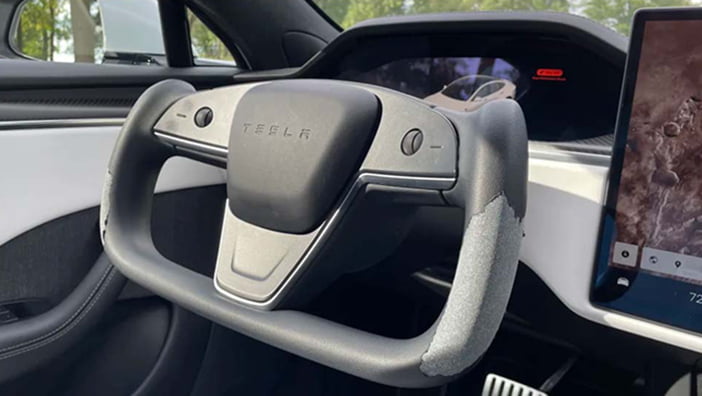
+++ VOLVO saw its August sales fall by 4.6% year-on-year to 43.666 vehicles as the global semiconductor shortage and other disruptions continued to hurt deliveries, the Swedish car maker said in a statement. Demand remained good, but the component shortages as well as power cuts and Covid-19 outbreaks in China interrupted output, the company said. Volvo said it would temporarily close its plant in the Chinese city of Chengdu due to local coronavirus restrictions and that a second facility had also been affected by recent lockdowns. +++


